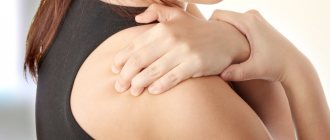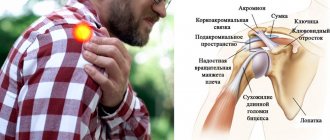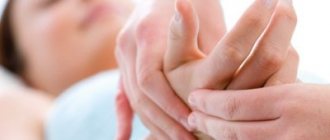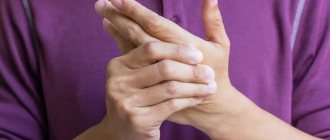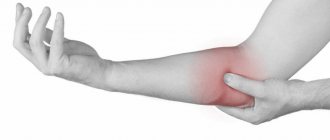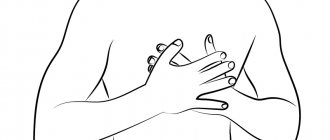In everyday life, we don't often pay attention to our shoulder joint. But our performance, the ability to play sports, and the quality of our life in general depend on the health and functionality of this unique structure of our body. That is why the sudden onset of pain when raising our arms literally deprives us of peace and the chance to comfortably engage in our normal, everyday activities. Why this symptom occurs, what it indicates and why it is so important to seek help from a doctor in time, we will tell you in this article!
How does pain manifest when raising your arm?
The pain syndrome that occurs with periarthritis of the shoulder joint (a whole complex of diseases that differ in their causes and clinical manifestations, but have a common relation to the periarticular apparatus of the shoulder) completely depends on the underlying pathology that provokes it. Therefore, pain when raising the arm in terms of strength and nature of manifestation can be:
- strong (which may indicate a shoulder injury, pinched nerve endings or inflammation of muscle tendons);
- acute (which may indicate damage to the shoulder joint due to sudden overload, for example, when lifting heavy objects);
- sharp (which may indicate a sudden load on the shoulder joint or an infection present in the articular nerve endings);
- burning (which may indicate the presence of an inflammatory process in the joint, as, for example, with osteochondrosis);
- aching (which may indicate serious internal disorders, such as angina pectoris and other heart pathologies);
- permanent (which may indicate a shoulder injury resulting in damage to the humerus);
- dull (which may indicate tendonitis);
- pulsating (which may indicate post-traumatic muscle strain of the shoulder muscles);
- long-term (which may indicate critical damage to the humerus due to dislocation).
Causes
Pain in the hands appears due to:
- bone fracture;
- ligament damage;
- injuries;
- strong physical activity;
- prolonged stay in an uncomfortable position;
- diseases of the musculoskeletal system;
- damage to nerve trunks;
- diseases of the heart, blood vessels;
- tendon inflammation;
- hand joint diseases.
With arthritis, pain appears in the early morning. Even during rest, the discomfort does not go away. There may also be swelling, hyperemia, and fever. With osteoarthritis, the cartilage of the joints becomes thin over time and leads to pain during physical activity, crunching, and difficulty moving.
If the cause is bursitis, then the pain manifests itself in the elbows, where swelling appears. The temperature also rises and the skin becomes red. Rheumatoid arthritis causes pain in small joints and morning stiffness.
How common is pain when raising your arm?
This symptom is quite common among both men and women of working age (from 40 to 65 years), and periarthritis of the shoulder joint is registered in more than 20% of people seeking help from a rheumatologist. This pathology can be provoked by:
- natural dystrophic and degenerative processes occurring in the body of elderly people (over 60 years old);
- deposition of calcium salts in the shoulder joint;
- injuries (often occurring at any age as a result of joint overload during sports, sudden jerking movements, etc.);
- the presence of internal diseases (for example, the cardiopulmonary system, etc.).
Rehabilitation and lifestyle restoration
After treatment, patients need to recover. This is achieved using:
- maintaining moderate physical activity;
- balanced nutrition;
- compliance with the work and rest regime;
- taking vitamin and mineral complexes;
- maintaining correct posture;
- protection against hypothermia of joints and stress;
- correction of deformed joints;
- disinfection of wounds, scratches and abrasions;
- refusal of monotonous and monotonous work;
- timely treatment of infectious diseases;
- limiting alcohol consumption.
What diseases can be associated with pain when raising your arm?
Most often, pain when raising the arm signals the presence of enthesopathy (damage followed by reactive inflammation at the junction of muscle tendons and ligaments with the bone surface) of the supraspinatus muscle. This symptom may indicate that the patient has:
- capsulitis (characterized by painful muscle stiffness in the shoulder girdle);
- shoulder dislocation;
- tendobursitis (characterized by inflammation of the joint capsules due to damage by tendon calcifications);
- lesions (deformation) of the rotator cuff (characterized by injury to the cuff due to non-standard or jerking movements, as well as delayed manifestation);
- intervertebral hernia (characterized by a pinched nerve, usually accompanied by pain in the neck);
- glenohumeral periarthritis syndrome (characterized by compaction and swelling of the periarticular soft tissues, which lose elasticity over time);
- diseases of internal organs (such as myocardial infarction, cerebrovascular accidents, pathologies of the lungs, gall bladder, etc.).
How to treat hand joints?
All existing treatment methods, both ultra-new and traditional, which the Alan Clinic Center for Neurology and Orthopedics uses in its work, are the safest and exclude surgical intervention.
The treatment process is always a comprehensive program with an individual approach to each of our patients. These treatment methods, consisting mainly of non-drug methods, are available not only to ordinary patients, but are acceptable for the treatment of infants, pregnant and lactating mothers.
We have at our disposal the following methods:
- Manual therapy
- Osteopathy is treatment done by a doctor, with a gentle effect on the musculoskeletal system, nervous and vascular systems, and internal organs.
- Medical massage
- Acupuncture - exposure to biologically active points with microneedles.
- Laser reflexology is a painless effect on reflexogenic zones and points.
- Tsubotherapy is a gentle effect on the reflex points of the body.
- Pharmacopuncture is the introduction of medicinal drugs of natural origin to the source of the problem.
- Plasma therapy is the introduction of the patient’s own purified blood into the site of the disease.
- Isometric kinesiotherapy - individual gymnastic techniques/exercises, according to indications, with elements of joint massage.
- Kinesiotherapy using the Exart installation
- Kinesio taping
- Ozone therapy is treatment with active oxygen.
- Physiotherapy
- Physiotherapy with enzyme preparations
- Medical droppers
- Hirudotherapy - treatment with leeches.
- Botulinum therapy is treatment with botulinum toxin.
- Intra-articular injection of synovial fluid endoprostheses
- Intra-articular blockades
All methods are recognized by official medicine, and doctors using them have appropriate certificates. The decision on the need to use certain medications during the course of treatment is made by the doctor, based on the complexity and severity of the disease, concomitant diseases, as well as the diagnosis.
Which doctor should you contact if you experience pain when raising your arm?
If this symptom appears, you should immediately contact a qualified orthopedic traumatologist in a modern clinic. Only in such conditions is it possible to carry out high-quality diagnostics and make the correct diagnosis, after which the patient will be prescribed adequate treatment based on the specific cause of the disease.
Are you or your loved ones experiencing pain when lifting your arm? Don't waste your precious time! Medical specialists are always ready to promptly determine the exact cause of your discomfort and most effectively return you to the joy of comfortable and healthy movement!
Kinds
Discomfort in the hands may vary, since there are different types of pain:
- Burning. There is discomfort and burning, often a feeling of “goose bumps”.
- Aching. Periodically intensify and weaken, maybe 20-30 minutes.
- Spicy. With them, mobility decreases, muscle weakness and discomfort appear.
- Shots. They appear suddenly and last 2-3 minutes. This kind of pain is also called “cutting”.
Whatever the type of pain, it causes a lot of inconvenience. Therefore, it is important to consult a specialist in a timely manner in order not only to eliminate unpleasant symptoms, but also to prevent negative consequences.
Exercise stress
“Body aches” after physical activity can occur both in untrained people and in professional athletes8. And the cause of discomfort is the accumulation of under-oxidized metabolic products in muscle cells; in particular, painful sensations are caused by an excessive amount of lactic acid (lactate)2. Less commonly, the cause is microtrauma, but this can only occur if the training rules are violated8.
Muscle soreness due to overwork does not occur immediately, but after a few hours or within 1-2 days after training or unusual physical activity and disappears within a week8.
How to find out the diagnosis
In order to establish a diagnosis for pain from the elbow to the hand in the right or left arm, first of all, examination data is used: many diseases and syndromes give an unambiguous reaction to certain motor tests, which easily makes it possible to establish a diagnosis.
X-ray or ultrasound examination can be used to clarify the diagnosis. Blood tests are rarely ordered. Diagnosis is carried out by a neurologist, a surgeon, and in rare cases, a cardiologist and an endocrinologist are involved.
What is the pain in the elbow on the inside?
The basis of the pain syndrome in this localization is inflammation of the structures of the elbow on the medial (inner) side. The result of this reaction is constant irritation of small nerve fibers that transmit pathological signals to the brain.
According to statistics, 70-80% of patients with pain in the area of the inner surface of the elbow can tolerate it. It is characterized by:
- monotony;
- slow increase in intensity;
- connection with physical activity - at rest, patients may not present any complaints.
Bending and turning the arm inward increases the discomfort. The pain can also spread to the shoulder area, axillary area, forearm, and thumb. This condition is often chronic.
Severe pain syndrome, requiring the use of analgesics, occurs with traumatic joint injuries. In this case, therapy is aimed at restoring the anatomy of the joint, which will lead to gradual pain relief.
Symptoms of the disease
Shoulder pain manifests itself in different ways depending on the cause. Acute is typical in case of injury. When a bruise, dislocation or sprain occurs, the patient experiences discomfort that increases when moving the upper limb. When a fracture occurs, it becomes impossible to move the arm.
Unbearable pain radiating to the neck and upper back is observed with capsulitis. In addition to pain, there is an inability to move the arm back or raise it. Severe pain also occurs with brachial neuritis and arthritis. The first is characterized by the absence of signs of inflammation in the joint; in the second case, swelling of the soft tissues and limited range of motion are noticeable.
Aching pain in the shoulder may be a sign of osteochondrosis of the cervicothoracic spine. Often the symptom is accompanied by numbness of the hand, burning and tingling sensation in the fingers. Aching pain is also observed with deforming arthrosis, but in this case, along with discomfort, a person notes stiffness of movement and swelling in the shoulder joint in the morning, crunching and clicking when bending/extending the arm. With the gradual destruction of cartilage, lifting heavy objects or active movement provokes increased pain.
Constant pain for several weeks is characteristic of bursitis, when the inflammatory process develops in the periarticular bursa. The disease is accompanied by the formation of a compaction, upon pressing on which a fluid transfusion is felt.
